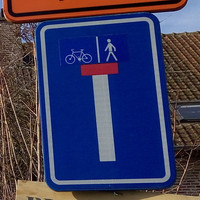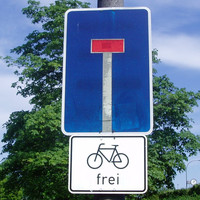 Filtered permeability
Filtered permeability
 Dead end sign with exception for pedestrians and cyclists (Belgium).
Dead end sign with exception for pedestrians and cyclists (Belgium).  Dead end sign with exception for cyclists (Germany).
Dead end sign with exception for cyclists (Germany).
Filtered permeability may be applied for two main reasons:
- to reduce the volume of car traffic along a cycle highway, and therefore allow safe and comfortable cycling in mixed traffic, without dedicated cycling infrastructure (see separation or integration)
- to reduce or eliminate car traffic across a cycle highway, and therefore reduce the risk of collision or interruption on a crossing (see safe crossings, non-signalised crossings)
Closing a short section of a street for motor vehicles
 Simple bollards. Diegem, Belgium.
Simple bollards. Diegem, Belgium. The simplest and most effective solution for filtered permeability are bollards or other obstacles (plants, barriers etc.) that make a street completely unpassable by car, while comfortably rideable by bike.
It is important to provide enough clearance (approximately 1.5 m/direction in straight line) for bicycles. Tight chicanes and similar solutions will make it impossible to use the route by less proficient cyclists, cyclists with kid trailers, cargo bikes etc. Such chicanes can also create artificial choke point and conflict points between different groups of users.
Opening a dead end for bicycles
 Section of dedicated cycle path on Quietway 1 in London connecting dead end of Rothsay St. with junction of Law St. and...
Section of dedicated cycle path on Quietway 1 in London connecting dead end of Rothsay St. with junction of Law St. and... The same effect can be reached from an opposite starting point: having a dead end for cars because of natural or artificial barrier (e.g. river or fence) and opening it for cyclists (e.g. by building a cycling bridge or removing a part of fencing).
Alternative solutions
 The "tractor gate" on Weverstraat in Zemst (Belgium) is a concrete block 20 cm high. It reduces the car traffic across...
The "tractor gate" on Weverstraat in Zemst (Belgium) is a concrete block 20 cm high. It reduces the car traffic across... If making a section of a street completely unpassable by cars is not feasible, there are also other, “partial” means to reduce through traffic across an area, such as:
- One-way filtered permeability: a “gate” that can be crossed only in one direction by cars, but both ways by bicycles;
- One-way streets with contraflow cycling allowed;
- Limited turning possibility on selected crossings (i.e. no left/right turn);
- Filtered permeability solutions that allow selected other vehicles than bicycles through (e.g. deliveries in specific hours, emergency vehicles, public transport, agricultural vehicles).
Note that the chosen direction for one-way solutions should make the local street unattractive for through traffic.
See also
Filtered permeability improves safety on cycle highway in Beuningen
Filtered permeability reducing the number of crossings with motorised traffic.
London Quietways
Filtered permeability in a megacity.
Filtered permeability on cycle highway C95 in Copenhagen
Example of application of filtered permeability on an important public transport corridor in Copenhagen, Denmark.
What does a tractor gate do on the F1 cycle highway?
Example of application of filtered permeability in rural area near Zemst, Belgium.
